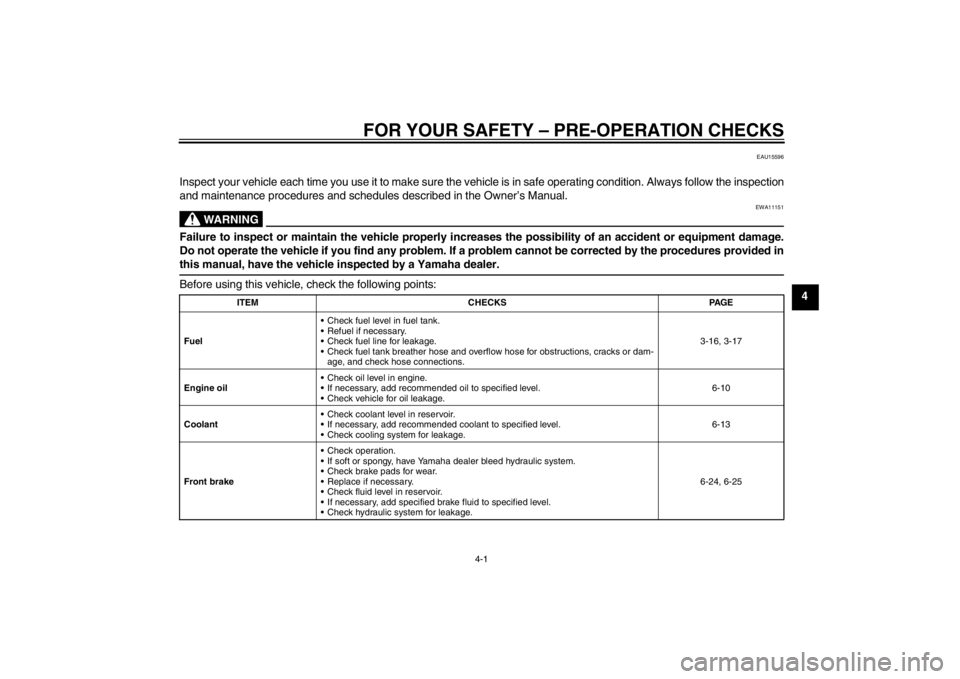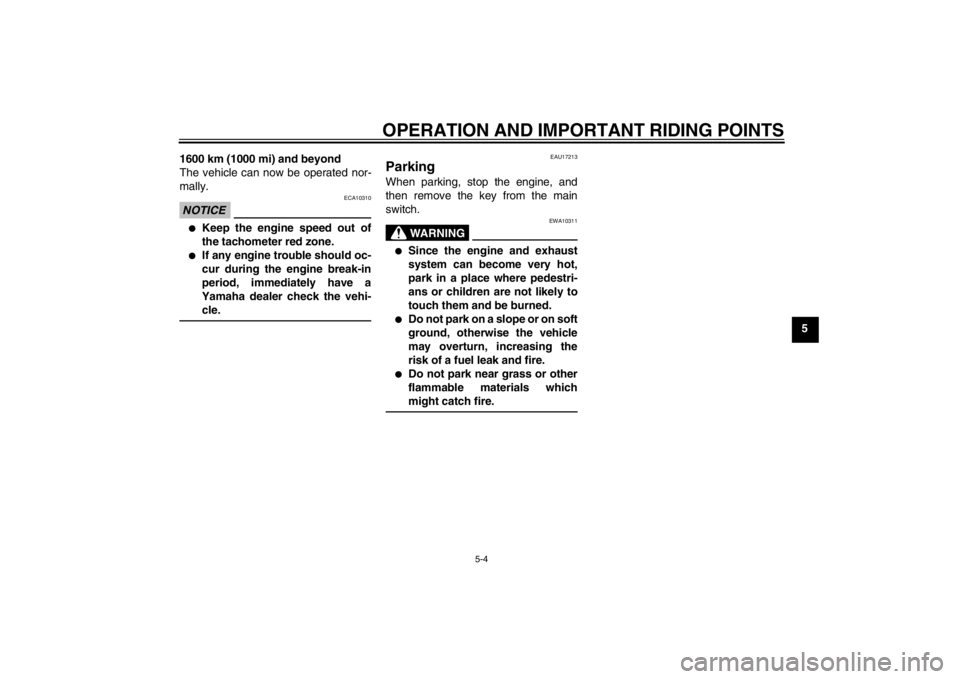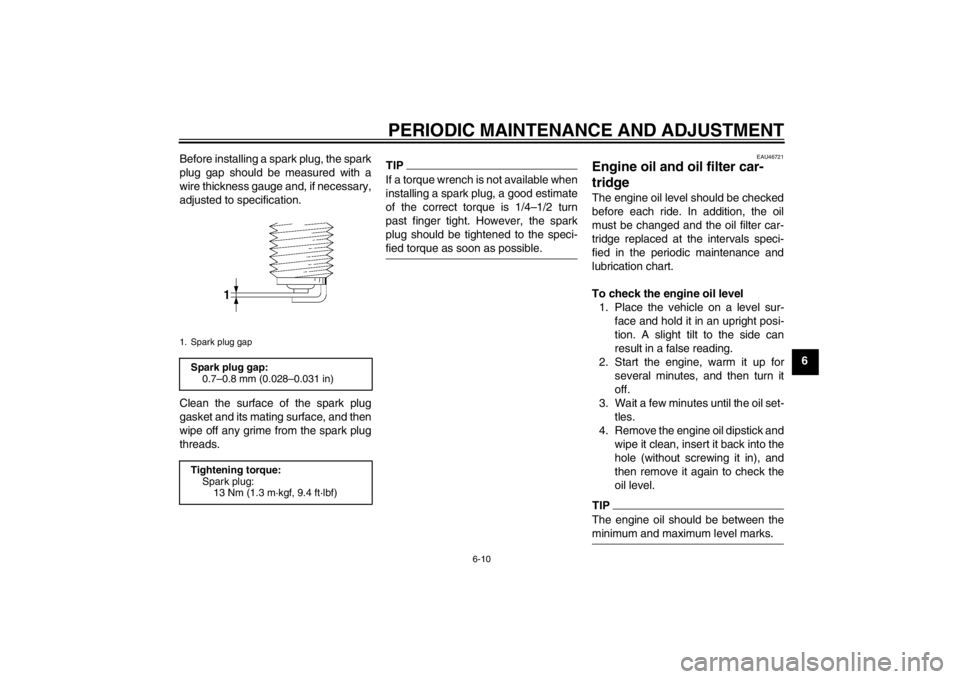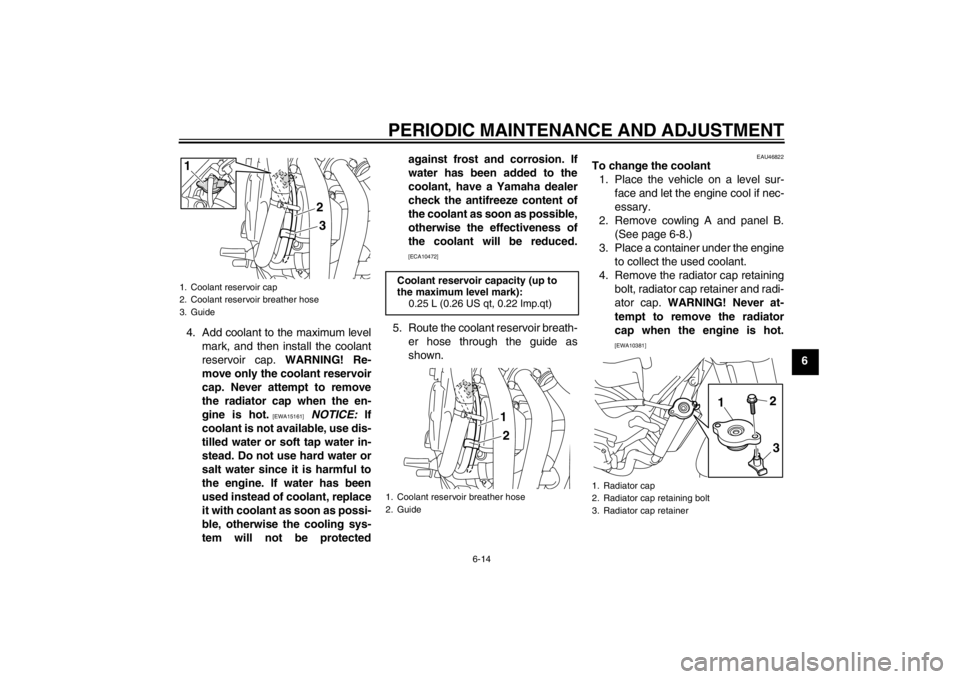check engine YAMAHA XJ6-N 2013 User Guide
[x] Cancel search | Manufacturer: YAMAHA, Model Year: 2013, Model line: XJ6-N, Model: YAMAHA XJ6-N 2013Pages: 104, PDF Size: 2.86 MB
Page 39 of 104

FOR YOUR SAFETY – PRE-OPERATION CHECKS
4-1
4
EAU15596
Inspect your vehicle each time you use it to make sure the vehicle is in safe operating condition. Always follow the inspection
and maintenance procedures and schedules described in the Owner’s Manual.
WARNING
EWA11151
Failure to inspect or maintain the vehicle properly increases the possibility of an accident or equipment damage.
Do not operate the vehicle if you find any problem. If a problem cannot be corrected by the procedures provided in
this manual, have the vehicle inspected by a Yamaha dealer.Before using this vehicle, check the following points:
ITEMCHECKS PAGE
Fuel Check fuel level in fuel tank.
Refuel if necessary.
Check fuel line for leakage.
Check fuel tank breather hose and overflow hose for obstructions, cracks or dam-
age, and check hose connections. 3-16, 3-17
Engine oil Check oil level in engine.
If necessary, add recommended oil to specified level.
Check vehicle for oil leakage. 6-10
Coolant Check coolant level in reservoir.
If necessary, add recommended coolant to specified level.
Check cooling system for leakage. 6-13
Front brake Check operation.
If soft or spongy, have Yamaha dealer bleed hydraulic system.
Check brake pads for wear.
Replace if necessary.
Check fluid level in reservoir.
If necessary, add specified brake fluid to specified level.
Check hydraulic system for leakage. 6-24, 6-25
U20SE3E0.book Page 1 Monday, April 23, 2012 10:47 AM
Page 43 of 104

OPERATION AND IMPORTANT RIDING POINTS
5-2
5
a warning or indicator light remains
on, see page 3-4 for the correspond-
ing warning and indicator light cir-
cuit check.
For ABS models:The ABS warning light should
come on when the main switch is
turned to “ON” and then go off after
traveling at a speed of 10 km/h (6
mi/h) or higher.
NOTICE
ECA17680
If the ABS warning light does not
come on and then go off as ex-
plained above, see page 3-4 for the
indicator light circuit check.2. Shift the transmission into the neu-
tral position. The neutral indicator
light should come on. If not, ask a
Yamaha dealer to check the elec- trical circuit.
3. Start the engine by pushing the start switch.
If the engine fails to start, release
the start switch, wait a few sec-
onds, and then try again. Each
starting attempt should be as short
as possible to preserve the bat- tery. Do not crank the engine more
than 10 seconds on any one at-
tempt.
NOTICE
ECA11042
For maximum engine life, never ac-
celerate hard when the engine is
cold!
EAU16671
Shifting Shifting gears lets you control the
amount of engine power available for
starting off, accelerating, climbing hills,
etc.
The gear positions are shown in the il-
lustration.TIPTo shift the transmission into the neu-
tral position, press the shift pedal down
repeatedly until it reaches the end of its
travel, and then slightly raise it.1. Shift pedal
2. Neutral position
1
N
2 3
4
5
6
1
2
U20SE3E0.book Page 2 Monday, April 23, 2012 10:47 AM
Page 45 of 104

OPERATION AND IMPORTANT RIDING POINTS
5-4
5
1600 km (1000 mi) and beyond
The vehicle can now be operated nor-
mally.
NOTICE
ECA10310
●
Keep the engine speed out of
the tachometer red zone.
●
If any engine trouble should oc-
cur during the engine break-in
period, immediately have a
Yamaha dealer check the vehi- cle.
EAU17213
Parking When parking, stop the engine, and
then remove the key from the main
switch.
WARNING
EWA10311
●
Since the engine and exhaust
system can become very hot,
park in a place where pedestri-
ans or children are not likely to
touch them and be burned.
●
Do not park on a slope or on soft
ground, otherwise the vehicle
may overturn, increasing the
risk of a fuel leak and fire.
●
Do not park near grass or other
flammable materials which
might catch fire.
U20SE3E0.book Page 4 Monday, April 23, 2012 10:47 AM
Page 48 of 104

PERIODIC MAINTENANCE AND ADJUSTMENT
6-3
6
EAU46861
TIP●
The annual checks must be performed every year, except if a kilometer-based maintenance, or for the UK, a
mileage-based maintenance, is performed instead.
●
From 50000 km (30000 mi), repeat the maintenance intervals starting from 10000 km (6000 mi).
●
Items marked with an asterisk should be performed by a Yamaha dealer as they require special tools, data and technical
skills.
EAU46910
Periodic maintenance chart for the emission control system NO. ITEM CHECK OR MAINTENANCE JOBODOMETER READING
ANNUAL
CHECK
1000 km
(600 mi) 10000 km
(6000 mi) 20000 km
(12000 mi) 30000 km
(18000 mi) 40000 km
(24000 mi)
1 *Fuel line Check fuel hoses for cracks or
damage. √√√√√
2 *Spark plugs Check condition.
Clean and regap.
√√
Replace. √√
3 *Valves Check valve clearance.
Adjust.
Every 40000 km (24000 mi)
4 *Fuel injection Adjust engine idling speed and
synchronization. √√√√√√
5 *Air induction sys-
tem Check the air cut-off valve, reed
valve, and hose for damage.
Replace the entire air induction system if necessary. √√√√√
U20SE3E0.book Page 3 Monday, April 23, 2012 10:47 AM
Page 51 of 104

PERIODIC MAINTENANCE AND ADJUSTMENT
6-6
6
19*Front fork Check operation and for oil leak-
age. √√√√
20 *Shock absorber as-
sembly Check operation and shock ab-
sorber for oil leakage. √√√√
21 Engine oil Change.
Check oil level and vehicle for oil
leakage. √√√√√√
22 Engine oil filter car-
tridge Replace.
√√√
23 *Cooling system Check coolant level and vehicle
for coolant leakage. √√√√√
Change with ethylene glycol anti- freeze coolant. Every 3 years
24 *Front and rear brake
switches Check operation.
√√√√√√
25 Moving parts and
cables
Lubricate.
√√√√√
26 *Throttle grip Check operation.
Check throttle grip free play, and
adjust if necessary.
Lubricate cable and grip housing. √√√√√
27 *Lights, signals and
switches Check operation.
Adjust headlight beam.
√√√√√√
NO. ITEM CHECK OR MAINTENANCE JOB
ODOMETER READING
ANNUAL
CHECK
1000 km
(600 mi) 10000 km
(6000 mi) 20000 km
(12000 mi) 30000 km
(18000 mi) 40000 km
(24000 mi)
U20SE3E0.book Page 6 Monday, April 23, 2012 10:47 AM
Page 54 of 104

PERIODIC MAINTENANCE AND ADJUSTMENT
6-9
6To install the panel
Place the panel in the original position,
and then install the bolts.
EAU19642
Checking the spark plugs The spark plugs are important engine
components, which should be checked
periodically, preferably by a Yamaha
dealer. Since heat and deposits will
cause any spark plug to slowly erode,
they should be removed and checked
in accordance with the periodic mainte-
nance and lubrication chart. In addition,
the condition of the spark plugs can re-
veal the condition of the engine.
The porcelain insulator around the cen-
ter electrode of each spark plug should
be a medium-to-light tan (the ideal color
when the vehicle is ridden normally),
and all spark plugs installed in the en-
gine should have the same color. If any
spark plug shows a distinctly different
color, the engine could be operating im-
properly. Do not attempt to diagnose
such problems yourself. Instead, have
a Yamaha dealer check the vehicle.
If a spark plug shows signs of electrode
erosion and excessive carbon or other
deposits, it should be replaced.
1. Panel B
2. Bolt
1
2
2
Specified spark plug:NGK/CR9E
U20SE3E0.book Page 9 Monday, April 23, 2012 10:47 AM
Page 55 of 104

PERIODIC MAINTENANCE AND ADJUSTMENT
6-10
6
Before installing a spark plug, the spark
plug gap should be measured with a
wire thickness gauge and, if necessary,
adjusted to specification.
Clean the surface of the spark plug
gasket and its mating surface, and then
wipe off any grime from the spark plug
threads.
TIPIf a torque wrench is not available when
installing a spark plug, a good estimate
of the correct torque is 1/4–1/2 turn
past finger tight. However, the spark
plug should be tightened to the speci-
fied torque as soon as possible.
EAU46721
Engine oil and oil filter car-
tridge The engine oil level should be checked
before each ride. In addition, the oil
must be changed and the oil filter car-
tridge replaced at the intervals speci-
fied in the periodic maintenance and
lubrication chart.
To check the engine oil level
1. Place the vehicle on a level sur- face and hold it in an upright posi-
tion. A slight tilt to the side can
result in a false reading.
2. Start the engine, warm it up for several minutes, and then turn it
off.
3. Wait a few minutes until the oil set- tles.
4. Remove the engine oil dipstick and wipe it clean, insert it back into the
hole (without screwing it in), and
then remove it again to check the
oil level.TIPThe engine oil should be between the
minimum and maximum level marks.
1. Spark plug gapSpark plug gap:0.7–0.8 mm (0.028–0.031 in)
Tightening torque: Spark plug:13 Nm (1.3 m·kgf, 9.4 ft·lbf)
U20SE3E0.book Page 10 Monday, April 23, 2012 10:47 AM
Page 58 of 104

PERIODIC MAINTENANCE AND ADJUSTMENT
6-13
610. Start the engine, and then let it idle
for several minutes while checking
it for oil leakage. If oil is leaking, im-
mediately turn the engine off and
check for the cause.
TIPAfter the engine is started, the engine
oil level warning light should go off if the
oil level is sufficient.NOTICE
ECA10401
If the oil level warning light flickers
or remains on even if the oil level is
correct, immediately turn the engine
off and have a Yamaha dealer check
the vehicle.11. Turn the engine off, wait a few min-utes until the oil settles, and then
check the oil level and correct it if
necessary.
12. Install the cowling.
EAU20070
Coolant The coolant level should be checked
before each ride. In addition, the cool-
ant must be changed at the intervals
specified in the periodic maintenance
and lubrication chart.
EAU46801
To check the coolant level 1. Place the vehicle on a level sur- face and hold it in an upright posi-
tion.TIP●
The coolant level must be checked
on a cold engine since the level
varies with engine temperature.
●
Make sure that the vehicle is posi-
tioned straight up when checking
the coolant level. A slight tilt to the
side can result in a false reading.
2. Check the coolant level in the cool-ant reservoir.TIPThe coolant should be between the
minimum and maximum level marks.
3. If the coolant is at or below theminimum level mark, remove the
coolant reservoir breather hose
from the guide, and then remove
the coolant reservoir cap.1. Coolant reservoir
2. Maximum level mark
3. Minimum level mark
1
2
3
U20SE3E0.book Page 13 Monday, April 23, 2012 10:47 AM
Page 59 of 104

PERIODIC MAINTENANCE AND ADJUSTMENT
6-14
6
4. Add coolant to the maximum level
mark, and then install the coolant
reservoir cap. WARNING! Re-
move only the coolant reservoir
cap. Never attempt to remove
the radiator cap when the en-
gine is hot.
[EWA15161]
NOTICE: If
coolant is not available, use dis-
tilled water or soft tap water in-
stead. Do not use hard water or
salt water since it is harmful to
the engine. If water has been
used instead of coolant, replace
it with coolant as soon as possi-
ble, otherwise the cooling sys-
tem will not be protected against frost and corrosion. If
water has been added to the
coolant, have a Yamaha dealer
check the antifreeze content of
the coolant as soon as possible,
otherwise the effectiveness of
the coolant will be reduced.
[ECA10472]
5. Route the coolant reservoir breath-
er hose through the guide as
shown.
EAU46822
To change the coolant1. Place the vehicle on a level sur- face and let the engine cool if nec-
essary.
2. Remove cowling A and panel B. (See page 6-8.)
3. Place a container under the engine to collect the used coolant.
4. Remove the radiator cap retaining bolt, radiator cap retainer and radi-
ator cap. WARNING! Never at-
tempt to remove the radiator
cap when the engine is hot.
[EWA10381]
1. Coolant reservoir cap
2. Coolant reservoir breather hose
3. Guide
3
1
2
Coolant reservoir capacity (up to
the maximum level mark):0.25 L (0.26 US qt, 0.22 Imp.qt)
1. Coolant reservoir breather hose
2. Guide
2
1
1. Radiator cap
2. Radiator cap retaining bolt
3. Radiator cap retainer
2
1
3
U20SE3E0.book Page 14 Monday, April 23, 2012 10:47 AM
Page 61 of 104

PERIODIC MAINTENANCE AND ADJUSTMENT
6-16
6
13. Install the radiator cap.
14. Install the coolant reservoir cap.
15. Start the engine, let it idle for sev-
eral minutes, and then turn it off.
16. Remove the radiator cap to check the coolant level in the radiator. If
necessary, add sufficient coolant
until it reaches the top of the radia-
tor, and then install the radiator
cap, radiator cap retainer and radi-
ator cap retaining bolt. 17. Check the coolant level in the res-
ervoir. If necessary, remove the
coolant reservoir cap, add coolant
to the maximum level mark, and
then install the cap.
18. Route the coolant reservoir breath- er hose through the guide as
shown. 19. Start the engine, and then check
the vehicle for coolant leakage. If
coolant is leaking, have a Yamaha
dealer check the cooling system.
20. Install the cowling and the panel.
Antifreeze/water mixture ratio: 1:1
Recommended antifreeze: High-quality ethylene glycol anti-
freeze containing corrosion inhibi-
tors for aluminum engines
Coolant quantity:
Radiator capacity (including all
routes):2.00 L (2.11 US qt, 1.76 Imp.qt)
Coolant reservoir capacity (up to the
maximum level mark): 0.25 L (0.26 US qt, 0.22 Imp.qt)
1. Radiator cap
2. Radiator cap retaining bolt
3. Radiator cap retainer
2
1
3
1. Coolant reservoir breather hose
2. Guide
2
1
U20SE3E0.book Page 16 Monday, April 23, 2012 10:47 AM